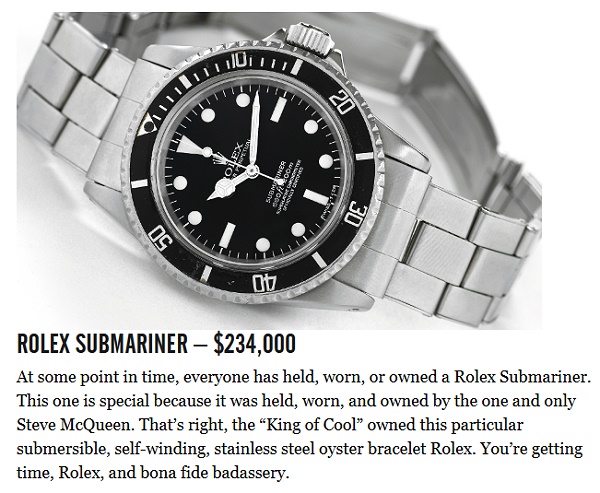Have you noticed the decline in the quality of many products that you have been purchasing over they last few years, but the prices have been going up? What gives?
And I am talking about everything from the lettuce in the grocery store, to watches, and consumer hifi equipment. The grocery stores have a neat trick. The product says, “Now with 10% more.” But, it’s 20% more expensive. They don’t expect you to notice that. Only that it has 10% more product in the package.
Let’s use watches as another example. I bought four watches of a particular well known brand, which had a good reputation for quality. I bought them over a 10 year period.
Three of the four became defective within two years of purchasing them. The store always exchanged them for another of the same model or had them repaired, even if they were out of warranty (the main reason I shop there). Since I always got a free replacement or repair, I didn’t pay much attention.
It wasn’t until I bought the fourth watch, which was one of the watches that became defective, that I realized 3/4 of that brand of watch was not working within a year of my purchasing them. They are made in Europe, and the movements are from Japan. They cost between $400 and $600. It’s a very famous brand.
At that point, I became very angry, even though the store had the fourth watch repaired (the factory tossed out the old movement and put in a new one – signifying that it was cheaper to just replace the movement than to spend time repairing the old one – a bad sign).
So, a few weeks ago, I bought a watch of a different brand, one that was advertised as being assembled in North America (parts brought in from Europe), and everyone was telling me this was a hot ticket. Here is a photo of the watch, with brand ID removed.

The watch cost between $500 and $800.
It works great, like the other four watches. Time will tell (pun intended) if it stays working. However, what I want to point out is the workmanship. It came in a very fancy box, with lots of literature, printed on expensive paper.
Notice the timing ring around the outer perimeter. What you do is turn the ring until the marker which is now at 12 o’clock, to where the minute hand is located, and this sets the time of the beginning of whatever you are timing. When your event is done, just read the number on the timing ring where the minute hand is.
But notice the numbers on the ring.
At 1 o’clock, the marker is fine. At 2 o’clock, the little white rectangle between the two and the ten are in line with the middle of the ten. At 3 o’clock, the marker is not aligned. At 4 o’clock, the 2 of the 20 is lined up with the rectangle. At 5 o’clock, everything is lined up. At 6 o’clock, the rectangle is lined up with the 3 of the 30. At 7 o’clock, everything is lined up. At 8 o’clock, the 4 is lined up with the rectangle. At 9 o’clock, there is slight mis-alignment. At 10 o’clock, the 5 of the 50 is lined up (remember, at 2 o’clock and 6 o’clock, the rectangle is lined up with the middle of the 10 and 30, respectively). And, at 11 o’clock, everything is lined up.
Clearly, the timing ring is not properly constructed so that all of the markers are lined up, making this feature useless for accurate timing.
Now, I probably would never have any use for the timing ring, but I certainly would expect it to be made accurately. What engineering does it take to make the ring with the markers in the correct places? Maybe they economized by using the same timing ring on all their watches that are the same diameter, even if the numbers on the face of the watch are not exactly in the same place. Well, economizing results in this sloppy workmanship. Does the carelessly made timing ring translate to the watch’s movement (the case and movement are purchased from the same country in Europe)? I will find out during the next year or so.
Bt contrast, here is a photo of a Rolex Mariner (this one was owned by Steve McQueen). Notice that the watch numbers (white dots) are lined up exactly in the center of the numbers in the timing ring. I mean, really, do you really have to pay thousands, just to get a simple alignment of a sliding elapsed time ring (a new Rolex Submariner that didn’t belong to a celebrity is about $8,500)?

(Photo copyright Hodinkee and Rolex.)
Our resident electrical engineer, Dr. David Rich, has found that with some consumer electronics, the newer models have replaced some of the innards with cheaper parts, usually chip sets (rather than resistors or capacitors). And yet, the price is higher.
Why is this happening? It is because we have moved to a global economy, and companies are more responsible to their stock holders than to their own pride of workmanship.
The small, privately owned companies don’t seem to be as subject to this as this as the public companies. But, the larger the company – private or public – the more likely you are to be purchasing a product that is made as cheaply as possible and sold for as much as possible.
Thirty years ago, if you bought a refrigerator, it would last at least at least two decades, maybe three. I have a vertical freezer that is thirty years old, and it still works fine. But I have gone through three refrigerators in 25 years, and the latest one has engineering mistakes that are very annoying.
What about our HDTV’s? They have become thinner and cheaper over the years, and probably will last just long enough to reach the point where the next higher resolution TVs will be coming available. We have come to the point of disposable consumer electronics. Like smart phones, we are expected to get a new player, receiver, and the next generation of TV, every few years. All because stockholders demand high profits, which results in stock value growth, and an increase in their stock portfolion value.
So, what will it take to get a receiver that has good DAC’s and a power supply that will deliver the specified output to all channels? $1,000, $2,000, $5,000? It’s probably the one that will make the stockholders the least happy.
Are you OK with this? I’m not.
What’s the solution? Write to your favorite companies whose products you buy, and demand better quality, or you will shop elsewhere. Will it work? Probably not, because the company has a million stockholders who demand high profits, or they will shop elsewhere. The irony is that they, the stockholders, are purchasing products that could be a lot better for the money, but their insistence on stock profits keeps the quality from achieving greater heights, so they have to settle for lower quality products themselves. We are victims of our own greed.
John E. Johnson, Jr.
Editor


